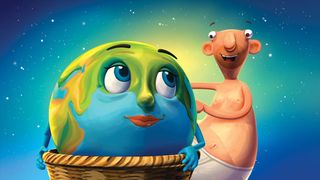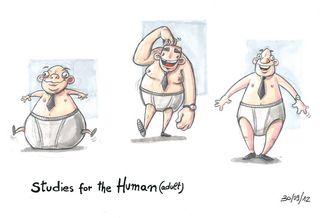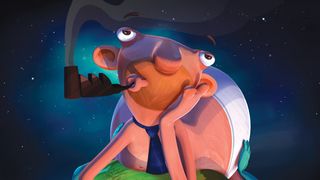Delightful eco-animation spreads sustainable message
Student animation uses humour and emotion to spread the word about respecting the environment.
'Espero' means 'hope' in Esperanto, a constructed language whose name itself translates as 'one who hopes'. The student team behind this beautiful short chose to use Esperanto for the animation because the philosophy behind the language's creation was fostering peace and international understanding between people.
Espero? is a film with a strong ecological message, one that it imparts with a unique visual style: treat our environment with respect or it will no longer be able to sustain us.
It's a serious message, but the student team - director and animator Simone Giampaolo, TD and animator Henrik Linnes, and art director Yifan Hu, all graduates of the National Centre for Computer Animation in Bournemouth, UK - cleverly bypassed any sense of lecturing by using humour and emotion.
I see animation as one of the most powerful mediums to reach a wide ranging audience
Director Giampaolo believes animation is the ideal medium for serious messages: "I see animation as one of the most powerful mediums to reach a wide ranging audience, from children to adults. What intrigues me most are the possibilities to use this medium to spread important messages and teachings while entertaining the audience. Animation allows you to talk about inconvenient and sensitive topics in a funny and relaxed way, which is much more difficult to achieve through live action."

Socially aware animators
Early inspirations for the story came from two illustrious animators who, throughout their career, have been using animation as a medium to deliver messages to the audience: Frédéric Back and Bruno Bozzetto.
"As our short film aims to present environmental issues created by the human race, we think we have a lot in common with Frédéric Back in terms of themes," Giampaolo explains.
With the main character, Andrew, the aim was to create an everyman that the audience could identify with, even at his worst. "Andrew is human," says Giampaolo, "and in a way too human. He can be described as the most shameful part of our modern society: selfish, greedy, lazy and not very smart. Andrew is an adult who has not grown up intellectually. He has got one talent though: his peculiar sense of survival, which enables him to promptly react when something endangers his existence."

As well as director, Simone took on the roles of story artist, character designer and animator: "The best thing about producing a short in a small team is that you get to try different roles and learn a lot about every step of production."
Technical issues fell to his colleague Henrik Linnes, who's roles were TD, lead modeller and animator. "The hardest job for me was definitely rigging. Not having done much rigging before, I struggled to get them to work the way I wanted. The funny thing is that, in the end, the rigs are what I'm most pleased with," he says
Creative workarounds
The team worked mainly in Maya, to give them a flexibile, but tight pipeline. "Since Maya is so flexible and can be adapted to many different situations, we found it was the perfect tool for a student project," says Linnes. "As a student working in a small team, you want to keep the pipeline as neat as possible; using such a multifunctional software as Maya was really beneficial."
The team also came up with some creative workarounds that made the modelling and rigging processes easier, says Linnes. "It was decided early on that the characters would all have their mouths textured and not modelled, which made modelling the characters a bit easier - and also that Andrew's underwear would be textured. The only other parts that needed to be modelled were Andrew’s tie and shoes.

"The model had to be adjusted further into the production as the rig needed to have detachable limbs. Separating the legs for the human, and both legs and arms for the earth and filling in the holes where the geometry was previously attached. It was important to do this as cleanly as possible so that it wouldn't mess up the UVs, or add problems to the rig," says Linnes.
Classic cartoon visuals
Using Maya was key to achieving Espero's cartoonish visual style, says art director Yifan Hu. "In Maya we managed to give the rigs the right amount of flexibility we needed for moving around, posing, squashing and stretching such round characters (the rubber hose feel of arms and legs was achieved by using flexi- planes)," she explains.
"Also, Maya became very effective in terms of lighting and rendering for achieving the cartoonish style. The biggest technical difficulty was the rigging," says Hu. "We needed the rigs to be able to squash, stretch, bend and behave in ways that made it possible to get the style that we wanted. As none of us had much experience with rigging we started off by making a basic rig and then added features that we needed later on as the character developed.

"To get the bendy limbs to work nicely without breaking or creating weird results, different methods like cluster and joint-based systems were tried out, but none of those gave us the flexibility and durability that we desired. In the end we used a follicle-based system to drive the deformations. The system was created separately from the rig and applied to the areas of the rigs where we wanted it."
Maya became very effective in terms of lighting and rendering for achieving the cartoonish style
Texturing was done in Mudbox and Photoshop, and was approached in the same way as when applying paint onto a canvas. "To achieve a painterly effect it is easier to paint on a flat surface, resulting in less image distortion," Hu explains. "It also helps to briefly mark down the particular positions - such as the eyes and nose - of the UV texture in Mudbox and then add details in Photoshop."
Hu feels that the student team managed to produce a polished animation in a short period of time. "The lighting and compositing techniques we used offered efficiency and flexibility in terms of lighting adjustment, both in production and in post." The whole animation was rendered out in less than a week, which gave the team time to go back and tweak details in the texturing, lighting and the overall animation.
Words: Rose Brandle
This article originally appeared in 3D World issue 179.

Thank you for reading 5 articles this month* Join now for unlimited access
Enjoy your first month for just £1 / $1 / €1
*Read 5 free articles per month without a subscription

Join now for unlimited access
Try first month for just £1 / $1 / €1
Get the Creative Bloq Newsletter
Daily design news, reviews, how-tos and more, as picked by the editors.
The Creative Bloq team is made up of a group of design fans, and has changed and evolved since Creative Bloq began back in 2012. The current website team consists of eight full-time members of staff: Editor Georgia Coggan, Deputy Editor Rosie Hilder, Ecommerce Editor Beren Neale, Senior News Editor Daniel Piper, Editor, Digital Art and 3D Ian Dean, Tech Reviews Editor Erlingur Einarsson and Ecommerce Writer Beth Nicholls and Staff Writer Natalie Fear, as well as a roster of freelancers from around the world. The 3D World and ImagineFX magazine teams also pitch in, ensuring that content from 3D World and ImagineFX is represented on Creative Bloq.
